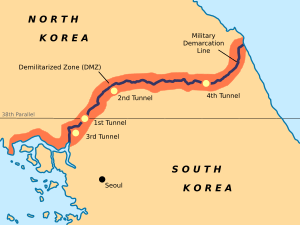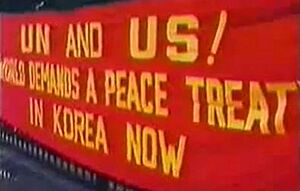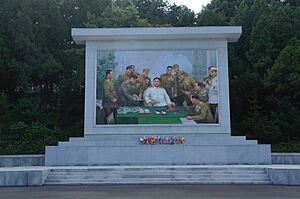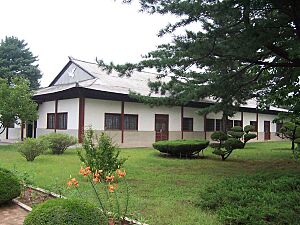Korean Armistice Agreement facts for kids

Delegates of both belligerent sides signing the Korean Armistice Agreement in Panmunjom, marking the beginning of the still-existing ceasefire between the two Koreas
|
|
| Type | Armistice |
|---|---|
| Signed | 27 July 1953 |
| Location | Panmunjom, Korea |
| Signatories |
|
| Parties |
|
| Languages | English, Korean, Chinese |
The Korean Armistice Agreement is a special agreement that stopped the fighting in the Korean War. It was signed on July 27, 1953. This agreement was made to "ensure a complete stop to fighting" in Korea. It was meant to last until a final peaceful solution could be found.
The agreement was signed by important leaders. These included William Kelly Harrison Jr. and Mark W. Clark for the United Nations Command (UNC). Also, Kim Il Sung and Nam Il signed for North Korea's army. Peng Dehuai signed for China's army.
Even though the agreement was signed, a full peace treaty was never made. This means the two Koreas are technically still at war. The agreement created the Korean Demilitarized Zone (DMZ). This zone is a new border between North and South Korea. It also arranged for prisoners of war to return home.
South Korea never signed the agreement. Its president, Syngman Rhee, wanted to unite Korea by force. China later made peace with South Korea in 1992. In 1994, China left the group that oversaw the armistice. This left only North Korea and the UN Command.
Contents
Why the Armistice Was Needed
By late 1950, the United States started talking about how to end the Korean War. They wanted to stop the fighting. They also wanted to make sure the war would not start again. The US suggested creating a special group to watch over the agreement. Both sides would agree to stop bringing in new soldiers or weapons. They also wanted a neutral zone, about 20 miles wide. The US also wanted to exchange prisoners of war.
South Korea's president, Syngman Rhee, did not want peace talks. He wanted his army to keep fighting. He hoped to unite all of Korea by force. The United Nations Command did not support his idea. Even so, Rhee tried to get the public to resist stopping the war. Other South Korean officials agreed with him. But later, the South Korean government decided to support the peace talks. President Rhee still disagreed.
North Korean leader Kim Il Sung also wanted to unite Korea. At first, North Korea was slow to support peace talks. But China and the Soviet Union pressured them. These allies were very important for North Korea to keep fighting.
How the Talks Happened
Peace talks began on July 10, 1951. They took place in Kaesong, a North Korean city. The main negotiators were General Nam Il from North Korea and Vice Admiral Charles Turner Joy from the United States. After two weeks, they agreed on five main topics to discuss. These topics guided the talks until the armistice was signed in 1953.
The five main topics were:
- Agreeing on what to discuss.
- Drawing a military border between the two sides. This would create a neutral zone.
- Making plans for a ceasefire and armistice. This included how a group would watch over the agreement.
- Arrangements for prisoners of war.
- Suggestions to the governments involved on both sides.
The talks went very slowly. There were long breaks between meetings. One long break started when North Korea claimed the meeting site was bombed. North Korea said a UN aircraft attacked the site. The evidence seemed fake. The talks did not start again for two months. The US would not allow talks in Kaesong anymore. So, Panmunjom, a nearby village, was chosen as the new location. Both sides agreed to share responsibility for protecting the village.
A big problem was what to do with prisoners of war. The North Koreans held 10,000 prisoners. The UN held 150,000. Many North Korean and Chinese soldiers did not want to go back home. This was a big problem for China and North Korea. In the end, a special group called the Neutral Nations Repatriation Commission was set up. It helped handle the prisoner exchange.
In 1952, Dwight D. Eisenhower became the new US president. He visited Korea to find a way to end the war. When the UN accepted India's idea for an armistice, the fighting stopped. The front line was near the Kansas Line. This was a line of UN positions north of the 38th parallel north.
Discussions continued slowly. One issue was drawing the exact border. China and North Korea wanted the border to be at the 38th parallel. But within weeks, both sides accepted the Kansas Line. In March 1953, Joseph Stalin died. This helped speed up the talks. The new Soviet leaders wanted the fighting to end quickly.
On July 19, 1953, the delegates agreed on all issues. On July 27, 1953, the Armistice was signed. It was signed by Nam Il for North Korea and China, and William K. Harrison Jr. for the UN. Twelve hours after signing, all parts of the agreement began. An international group called the Neutral Nations Supervisory Commission (NNSC) was created. Its job was to make sure no new soldiers or weapons were brought into Korea. Teams from Czechoslovakia, Poland, Sweden, and Switzerland worked across Korea.
What the Agreement Says

The armistice is a military agreement. It is not a peace treaty between governments. No country officially signed it. It just stopped the fighting. The agreement created a "complete stop of all fighting in Korea." This was to be enforced by the commanders of both sides.
Since it's not a peace treaty, normal relations between the two Koreas were not restored. The armistice created the Military Demarcation Line (MDL) and the DMZ. The DMZ is a 2.5-mile-wide buffer zone. It follows the Kansas Line, where the armies were fighting when the armistice was signed. Today, the DMZ is one of the most heavily guarded borders in the world.
The Armistice also had rules about prisoners of war. It said that within 60 days, each side would send back prisoners who wanted to return.

In the end, over 22,000 North Korean or Chinese soldiers refused to go back home. Also, 327 South Korean, 21 American, and 1 British soldier chose to stay in North Korea or China.
After the Armistice was signed, the war ended. Even after three years of fighting, the border between North and South Korea stayed almost the same as before the war.
What Happened After
Geneva Conference Did Not Bring Peace
The Armistice Agreement said that a political meeting should happen within three months. This meeting would try to find a peaceful solution for Korea. This meeting, called the 1954 Geneva Conference, happened in April 1954. It was six months late. The meeting discussed conflicts in Korea and Indochina.
The US, USSR, France, China, and both Koreas were there. China suggested a peace treaty for Korea. But the US did not want to discuss it. So, no progress was made on a peace treaty for the Korean Peninsula.
Changes to the Agreement
The armistice said that neither side should bring new weapons into Korea. They could only replace old equipment. But in 1956, the US decided to bring atomic weapons into South Korea. This broke the armistice agreement. The US said North Korea had brought in new jet fighters.
In 1957, the US told North Korea they were no longer following this rule. In 1958, nuclear missiles and atomic cannons were sent to South Korea. North Korea said the US had brought in new weapons earlier. North Korea then built strong underground forts. They also moved their army closer to the border. This was to make it risky for the US to use nuclear weapons. In 1963, North Korea asked the Soviet Union and China for help to build nuclear weapons, but they refused.
North Korea's Announcements to Leave the Agreement

North Korea has said it would no longer follow the armistice many times. This happened in 1994, 1996, 2003, 2006, 2009, and 2013.
In 1994, North Korea said it would stop taking part in the Military Armistice Commission. They said the US sending Patriot missiles to South Korea ended the armistice. China also stopped participating in the commission in 1994.
In 2002, US President George W. Bush called North Korea part of an "Axis of Evil." In 2006, North Korea tested its first nuclear weapon. There were also violent events in 2010. These included the sinking of a South Korean ship and the bombing of an island. In 2010, the US said a peace treaty could only happen if North Korea stopped its nuclear program.
In 2011, South Korea said North Korea had broken the armistice 221 times.
In 2013, North Korea argued that the armistice was only meant to be temporary. They said they had offered to replace it with a peace treaty many times. But the US had not taken them seriously. North Korea also believes that US and South Korean military exercises are a threat. They said US ships with nuclear weapons were part of these exercises.
In March 2013, North Korea said it was ending all non-aggression agreements with South Korea. They also closed the border and the direct phone line. North Korea even said it had the right to make a nuclear attack first. The United Nations said the armistice could not be ended by just one side. The US then sent B-2 stealth bombers to South Korea for military exercises. North Korea responded by saying its rockets were ready to attack US targets. In May 2013, North Korea offered to talk about a peace treaty.
In 2016, North Korea put anti-personnel mines near the Bridge of No Return. This was to stop its border guards from leaving. The UN Command said this broke the armistice.
Later in 2016, North Korea suggested formal peace talks. The US changed its position. It said talks could happen if North Korea halted its nuclear program. But these talks did not happen.
Panmunjom Declaration
On April 27, 2018, the Panmunjom Declaration was signed. South Korean President Moon Jae-in and North Korean leader Kim Jong Un signed it. They agreed to work towards denuclearization. They also agreed to talk about formally ending the Korean War. They hoped to turn the armistice into a full peace treaty later that year.
However, North Korea later canceled talks with South Korea. They blamed US-South Korean military exercises. This also put a planned meeting with the US president in doubt.
The 2018 North Korea–United States Singapore Summit happened on June 12, 2018. Kim Jong Un and US President Donald Trump signed a joint statement. They agreed to:
- Build new US-North Korea relations for peace.
- Work together for lasting peace on the Korean Peninsula.
- Work towards complete denuclearization of the Korean Peninsula.
- Recover remains of soldiers missing in action.
The statement also said Trump would give security guarantees to North Korea. There would be more talks between US and North Korean officials.
Later, Kim Jong Un met with South Korean President Moon Jae-in again. Kim said his meeting with Trump brought "geopolitical stability." He expected more progress in talks with the US. Kim also thanked Moon for making the Singapore summit possible. The two leaders also agreed to try to co-host the 2032 Olympic Games. They also planned to "participate jointly" in international sports.
Remembering the Armistice
US Presidents have made special announcements to remember the National Korean War Veterans Armistice Day. For example, President Donald Trump made this announcement on July 26, 2017.
North Korea celebrates July 27 as a national holiday. They call it the Day of Victory in the Great Fatherland Liberation War.
Images for kids
See also
- Korean conflict
- Mutual Defense Treaty (United States–South Korea)
- Northern Limit Line
- Korean reunification
- North Korea and weapons of mass destruction









